|
|
|
Sort Order |
|
|
|
Items / Page
|
|
|
|
|
|
|
| Srl | Item |
| 1 |
ID:
175894
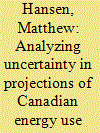

|
|
|
|
|
| Summary/Abstract |
This paper analyzes the uncertainty associated with Reference Case, or baseline, projections of Canadian energy use and production. We use the Canada Energy Regulator's Energy Futures modeling system to explore the impacts of changing key assumptions. The choice of assumptions and magnitude of change are guided by the scenarios in the Energy Modeling Forum (EMF) 34 project. We find important variations across all scenarios. In particular, we note that Canada's role as an energy producer is important for interpreting projection and scenario results. Overall, this analysis shows that it is important to test key assumptions in a typical Reference Case projection. However, this analysis also highlights many complexities in energy system modeling. It is also important to consider the potential interplay between key variables. This speaks to the importance of broader scenario analysis, where multiple assumptions are changed in an internally consistent way, as a useful complement to the focused scenario analysis found in this paper.
|
|
|
|
|
|
|
|
|
|
|
|
|
|
|
|
| 2 |
ID:
127160


|
|
|
|
|
| Publication |
2014.
|
| Summary/Abstract |
Among natural gas producing nations, there has been some concern about how the Asia Pacific will meet future demand for energy. We argue that natural gas, both regional and global, will play a vital role. Estimates of potential gas consumption in the region are analyzed and used to develop consensus projections to 2030. These consumption profiles are compared with gas supply estimates including indigenous, pipeline and LNG for the Asia Pacific market. From this analytical framework, we find that demand will be sufficiently large to accommodate supplies from diverse sources including North America, the Middle East, Central Asia, Russia, and the Asia Pacific itself. An important policy implication is that gas producing and consuming nations should benefit from promoting gas trade and not be concerned about a situation of potential lack of demand coupled with oversupply.
|
|
|
|
|
|
|
|
|
|
|
|
|
|
|
|
| 3 |
ID:
166352
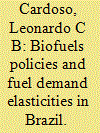

|
|
|
|
|
| Summary/Abstract |
Biofuels are often seen by policymakers as solutions to concerns about the environment, energy diversification, and rural development. To understand the impacts of biofuel policy, however, it is important to understand demand elasticities. Brazil, a leader in biofuels, provides a unique setting to increase our knowledge about biofuel policy and the interactions within and between the gasoline and ethanol markets. We estimate own-price, cross-price, and income elasticities of the demand for ethanol and gasoline using a novel instrumental variable approach to control for the inherent endogeneity between supply and demand. This results in own-price elasticities for both fuels higher than previous literature suggests: approximately − 0.9 for gasoline and − 1.5 for ethanol. Income elasticities for both fuels are approximately 0.8. We also examine the elasticity impacts following the introduction of flex-fuel cars into the Brazilian market. By estimating the model with over 100 subsamples across time, we find that cross-price elasticities become positive, significant, and increasing, but only after larger market penetration of flex-fuel cars, which occurred approximately three years after their introduction.
|
|
|
|
|
|
|
|
|
|
|
|
|
|
|
|
| 4 |
ID:
117613
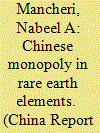

|
|
|
|
|
| Publication |
2012.
|
| Summary/Abstract |
The concentration of rare earth elements (REEs) production in China raises the vital issue of supply susceptibility. Until recently, the global dependency on China for rare earths was a well-kept secret. But word started to spread fast after Beijing cut export quotas by 70 per cent for the second half of 2010, sending prices of some oxides-the purified form of rare earth elements sky-rocketing. This article seeks to evaluate what rare earth elements are and explores China's role in the global supply-demand equations. It also explores the history of rare earth elements and China's current monopoly over the industry, including possible repercussions if rare earth elements supply were to be disrupted.
|
|
|
|
|
|
|
|
|
|
|
|
|
|
|
|
| 5 |
ID:
107490
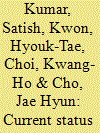

|
|
|
|
|
| Publication |
2011.
|
| Summary/Abstract |
An unceasing growth of gas consumption in domestic households, industry, and power plants has gradually turned natural gas into a major source of energy. Main drivers in this development are the technical and economic advantages of natural gas. It is a clean, versatile, and easily controllable fuel. On this basis, natural gas is often considered the form of energy that will be the "bridging fuel" to a sustainable energy system, sometime after 2050. Unlike other main sources of energy, such as oil and coal, gas is not traded on an actual world market. This paper provides an overview on demand and supplies of natural gas (LNG) in the past as a function of gas prices, gas technology (gas sweetening, liquefaction, shipping and re-gasification), and gas market and how they have changed recently. It also discusses the likely developments in global LNG demand for the period to the year 2030.
|
|
|
|
|
|
|
|
|
|
|
|
|
|
|
|
| 6 |
ID:
105769
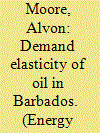

|
|
|
|
|
| Publication |
2011.
|
| Summary/Abstract |
The importation of oil is a significant component of Barbados' imports, rising from 7% of imports in 1998 to over 20% in 2009. This increase has impacted greatly on the level of foreign reserves. As a price-taker, relying entirely on imported oil for our energy needs could prove a continuous drain on the economy. With a view to formulating an appropriate energy policy for Barbados, this paper analyses the demand for oil using monthly data from 1998 to 2009. The paper estimates the elasticities of demand for oil by employing PesAran (2001) single equation cointegration approach and comparing the results with countries that rely heavily on imported oil and whose policy objective are to alter their energy structure to rely less on imported oil. The results show that the demand for oil imports is price inelastic in the long run. The consumption of oil is responsive to past consumption, prices, income, electricity consumption and the number of appliances imported in the short-run. A policy framework to reduce the use of oil for electricity consumption via alternative energy sources should be considered and the taxation of oil imports given its elasticity is a good source of revenue.
|
|
|
|
|
|
|
|
|
|
|
|
|
|
|
|
| 7 |
ID:
083241


|
|
|
|
|
| Publication |
2008.
|
| Summary/Abstract |
In recent years, there has been a growing number of studies that investigate the economic effects of military spending using a variety of estimation methods and focusing either on individual countries or on groups of relatively homogeneous countries. The situation is not the same as far as the demand for military expenditure is concerned, where less attention has been given and the majority of empirical studies have focused on individual countries, with only a few focusing on groups of countries and employing cross-sectional or panel data approaches. A region that has not attracted any research interest regarding the determinants of military expenditure is the European Union (EU) with the exception of individual country studies (mainly for the UK, Greece, France, Spain, Portugal). This paper argues that understanding the determinants of military spending in these countries is very important, especially given the discussions in recent years towards the development of a Common European Security and Defence Policy (CESDP). It then follows Dunne et al. (2003) and employs the Autoregressive Distributed Lag (ARDL) approach to cointegration to estimate a general model of aggregate defence spending for each of the 15 core EU countries over the period 1961-2005. The findings indicate that there is very little uniformity in the factors that determine each country's demand for military expenditure, something that needs to be borne in mind by policy makers when burden-sharing issues are considered in the development of the CESDP.
|
|
|
|
|
|
|
|
|
|
|
|
|
|
|
|
| 8 |
ID:
083242


|
|
|
|
|
| Publication |
2008.
|
| Summary/Abstract |
This paper considers the interpretation of the empirical results of the developing literature on the demand for military spending that specifies a general model with arms race and spill-over effects and estimates it on cross-section and panel data. It questions whether it is meaningful to talk of an 'arms race' in panel data or cross-section data, and suggests that it may be more appropriate to talk about the relevant variables - aggregate military spending of the 'Security Web' (i.e. all neighbours and other security-influencing powers) and the aggregate military spending of 'Potential Enemies' - as acting as proxies for threat perceptions, which will reflect both hostility and capability.
|
|
|
|
|
|
|
|
|
|
|
|
|
|
|
|
| 9 |
ID:
164520
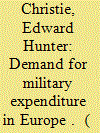

|
|
|
|
|
| Summary/Abstract |
A variant of established work on the demand for military expenditure is developed based on a practical concept of fiscal space from the perspective of short-term government choices concerning public expenditures. A new indicator, referred to as fiscal capacity, is defined and used as a candidate explanatory variable in an empirical model of European defence spending over the 2007–2016 period. Fiscal capacity is found to outperform simpler measurements of economic conditions, notably GDP growth forecasts, in explaining changes in defence spending efforts as a share of GDP. Regarding security environment variables, the results suggest that Russia has recently come to be seen as a potential military threat by European nations, leading to defence spending increases, the more so the shorter the distance to stationed or deployed Russian forces, and particularly so by those European nations that have a land border with Russia. A prospective exercise is then carried out in order to assess the capacity of EU member states that are also members of NATO to reach NATO’s 2% goal for defence spending over a mid-term horizon.
|
|
|
|
|
|
|
|
|
|
|
|
|
|
|
|
| 10 |
ID:
097545
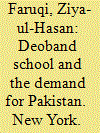

|
|
|
|
|
| Publication |
New York, Asia Publishing House, 1963.
|
| Description |
xi, 148p.
|
| Contents |
B
|
|
|
|
|
|
|
|
|
|
|
|
Copies: C:1/I:0,R:0,Q:0
Circulation
| Accession# | Call# | Current Location | Status | Policy | Location |
| 055281 | 370.95491/FAR 055281 | Main | On Shelf | General | |
|
|
|
|
| 11 |
ID:
117691
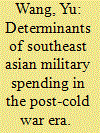

|
|
|
|
|
| Publication |
2013.
|
| Summary/Abstract |
This study examines the demand of military expenditure among Southeast Asian countries since the end of the Cold War. By using a dynamic panel approach, I find that military spending in the region has been jointly determined by economic, strategic and socio-political factors. In particular, surging foreign debt burdens and the rise of China - two regional issues that gained prominence in the post-Cold War period - show their significance as determinants along with other generalist variables. The results therefore ask for the development of even-handed and region-sensitive approaches to studying military build-up in the region of Southeast Asia.
|
|
|
|
|
|
|
|
|
|
|
|
|
|
|
|
| 12 |
ID:
110384


|
|
|
|
|
| Publication |
2011.
|
| Summary/Abstract |
This paper estimates price and fuel expenditure elasticities of demand by applying the linear Approximate Almost Ideal Demand system (LA-AIDS) to 3665 households sampled across Kenya in 2009. The results indicate that motor spirit premium (MSP), automotive gas oil (AGO) and lubricants are price elastic while fuel wood, kerosene, charcoal, liquefied petroleum gas (LPG) and electricity are price inelastic. Kerosene is income elastic while fuel wood, charcoal, LPG, electricity, MSP and AGO are income inelastic. The results also reveal fuel stack behaviour, that is, multiple fuel use among the households. Main policy implications of the results include increasing the penetration of alternative fuels as well as provision of more fiscal incentives to increase usage of cleaner fuels. This not withstanding however, the household income should be increased beyond a certain point for the household to completely shift and use a new fuel.
|
|
|
|
|
|
|
|
|
|
|
|
|
|
|
|
| 13 |
ID:
109432
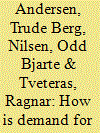

|
|
|
|
|
| Publication |
2011.
|
| Summary/Abstract |
This paper estimates the response of manufacturing sectors' natural gas demand to price and output changes. The average response to future changes in absolute and relative prices of the manufacturing industry in an OECD country depends on the mix of manufacturing industries, particularly with respect to energy intensity and substitution opportunities in production. We estimate short and long run demand elasticities using a shrinkage estimator, which allows heterogeneous demand responses across industries for each country. Our results show that price and output elasticities are heterogeneous within the same manufacturing sector across countries. Furthermore, an output contraction due to e.g. demand shocks will generally have larger negative effects on gas demand than increases in natural gas prices.
|
|
|
|
|
|
|
|
|
|
|
|
|
|
|
|
| 14 |
ID:
182461
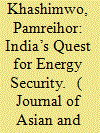

|
|
|
|
|
| Summary/Abstract |
India’s energy security is intricately linked to economic and population growth, accessibility, availability, affordability, and supply and demand. India’s quest for energy security is going slow and after a late start. India embraced various domestic efforts and has drawn up supplier relationships around the globe in coal, oil, gas, nuclear, hydroelectric power, and renewable energy. It appears India is not likely to be fully independent of external sources of supply for its energy requirements in the short-term and medium-term. There is no major technological breakthrough in alternative energy to free the country from its energy predicament, thus, India needs to adopt multi-dimensional strategic energy security approaches. In the absence of major oil and gas reserves in Indian territory, the country may be forced down a perilous path that includes a massive increase in the use of coal, associated with environmental concerns, and increasing dependence on external sources. The key focus of the study is to examine the key concerns, trends, challenges, and various options available to India to face the challenges in energy security.
|
|
|
|
|
|
|
|
|
|
|
|
|
|
|
|
| 15 |
ID:
143377
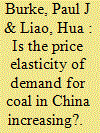

|
|
|
|
|
| Summary/Abstract |
China's dependence on coal is a major contributor to local and global environmental problems. In this paper we estimate the price elasticity of demand for coal in China using a panel of province-level data for 1998–2012. We find that provincial coal demand has become increasingly price elastic. As of 2012 we estimate that this elasticity was in the range − 0.3 to − 0.7 in point estimate terms when responses over two years are considered. The results imply that China's coal market is becoming more suited to price-based approaches to reducing emissions. The elimination of coal consumption subsidies could reduce national coal use and related emissions by around 2%.
|
|
|
|
|
|
|
|
|
|
|
|
|
|
|
|
| 16 |
ID:
028551
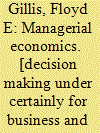

|
|
|
|
|
| Publication |
Massachusetts, Addison-Wesley Publishing Company, 1969.
|
| Description |
vii, 296p.Hbk
|
|
|
|
|
|
|
|
|
|
|
|
Copies: C:1/I:0,R:0,Q:0
Circulation
| Accession# | Call# | Current Location | Status | Policy | Location |
| 003575 | 658.403/GIL 003575 | Main | On Shelf | General | |
|
|
|
|
| 17 |
ID:
111310
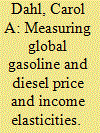

|
|
|
|
|
| Publication |
2012.
|
| Summary/Abstract |
Price and income elasticities of transport fuel demand have numerous applications. They help forecast increases in fuel consumption as countries get richer, they help develop appropriate tax policies to curtail consumption, help determine how the transport fuel mix might evolve, and show the price response to a fuel disruption. Given their usefulness, it is understandable why hundreds of studies have focused on measuring such elasticities for gasoline and diesel fuel consumption. In this paper, I focus my attention on price and income elasticities in the existing studies to see what can be learned from them. I summarize the elasticities from these historical studies. I use statistical analysis to investigate whether income and price elasticities seem to be constant across countries with different incomes and prices. Although income and price elasticities for gasoline and diesel fuel are not found to be the same at high and low incomes and at high and low prices, patterns emerge that allow me to develop suggested price and income elasticities for gasoline and diesel demand for over one hundred countries. I adjust these elasticities for recent fuel mix policies, and suggest an agenda of future research topics.
|
|
|
|
|
|
|
|
|
|
|
|
|
|
|
|
| 18 |
ID:
133146
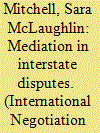

|
|
|
|
|
| Publication |
2014.
|
| Summary/Abstract |
This commentary provides a brief summary of the articles in this special issue and emphasizes four questions raised by this research: 1) ways to define and measure mediators' strategies, 2) teasing out demand side factors from supply side factors in mediation, 3) capturing differences between states and international organizations as conflict managers, and 4) understanding the role of particular conflict management actors like the International Criminal Court.
|
|
|
|
|
|
|
|
|
|
|
|
|
|
|
|
| 19 |
ID:
159019
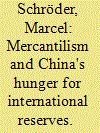

|
|
|
|
|
| Summary/Abstract |
This paper is motivated by the popular view that the surge in China's foreign exchange reserves is due to a distortionary exchange rate policy aimed at keeping the real exchange rate undervalued to support export-led growth. It undertakes an in-depth empirical investigation to quantify how much “mercantilist” and “precautionary” motives have contributed to the reserve build-up in China during 1998Q4-2011Q4. A substantial problem is that theory is consistent with employing two vastly differing approaches to defining and estimating the role of mercantilist reserve accumulation. A priori, either method could generate misleading results. The study shows, however, that the distinction between the two approaches is immaterial in China's case. The results suggest that mercantilism accounts for less than 10% of reserve accumulation. Precautionary motives and other factors seem to be the dominant determinants of the surge in China's international reserves.
|
|
|
|
|
|
|
|
|
|
|
|
|
|
|
|
| 20 |
ID:
101497


|
|
|
|
|
| Publication |
2010.
|
| Summary/Abstract |
The objective of this analysis is mainly to construct an intuitive measure of the performance of the National Rural Employment Guarantee Scheme (NREGS) in India. The focus is on divergence between demand and supply at the district level. Some related issues addressed are: (i) whether the gap between demand and supply responds to poverty; and (ii) whether recent hikes in NREGS wages are inflationary. Our analysis confirms responsiveness of the positive gap between demand and supply to poverty. Also, apprehensions expressed about the inflationary potential of recent hikes in NREGS wages have been confirmed. More importantly, higher NREGS wages are likely to undermine self-selection of the poor in it.
|
|
|
|
|
|
|
|
|
|
|
|
|
|
|
|
|
|
|
|
|